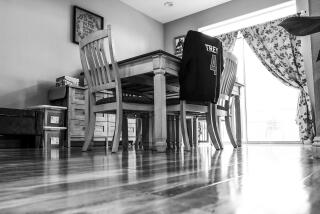Father’s Quest May Help Others Cope With Suicide
- Share via
Allison H. Raleigh was 22 when she took her life on a sunny Sunday afternoon in September, 1985, ending years of secret self-hatred.
Her father, a research chemist and executive for Rockwell International in Thousand Oaks, was angry at first.
But he also felt a desire to make Allison’s death a beginning as well as an ending and, later this month, that desire will bear fruit in a national conference at UCLA aimed at understanding and preventing teen-age suicide.
Allison’s father, Douglas Raleigh, started a memorial fund with about $5,000 from her college fund, the sale of her car and donations from friends. But he wanted to do more than merely donate money to an established suicide-related charity.
In coming to grips with his daughter’s death, Raleigh, 58, read her diaries and letters, sought out experts and others who had suffered the deaths of children and began reading literature on youth suicide.
Positive Alternatives
His search led him to the C. G. Jung Institute and James Hillman, a Jungian psychoanalyst who says that therapy can transform the urge to commit suicide into positive alternatives.
Raleigh said he was strongly attracted to Hillman’s ideas and, when he found that the institute was considering sponsoring a suicide conference, became directly involved. Although a layman on the subject, he has spent 18 months helping organize the conference.
The memorial fund also will help pay for the April 23-24 gathering, which is aimed at providing social workers, educators and therapists with the latest data on teen suicide from experts. Co-sponsors are the C. G. Jung Institute of Los Angeles and UCLA’s School of Education.
Among the speakers will be Dr. Edwin Schneidman, a professor at the UCLA School of Medicine and a leading suicide-prevention researcher; Dr. Rudolph Ekstein, a psychoanalyst; Karl Harris, an investigator for the Los Angeles County coroner’s office, and Dr. Michael Peck, who developed the state Department of Education’s suicide prevention curriculum.
National statistics show that suicide among young people has leveled off in the last few years after rising for several decades. Still, nearly 5,000 people between the ages of 15 and 24 killed themselves in 1986.
‘Give Life a Chance’
“We’re all really charged with trying to preserve for young people the opportunity to experience a life,” said Raleigh, who will greet participants at the conference. “Young people . . . have no idea what life has in store for them, and we have to say, ‘Hey, give life a chance.’ ”
Allison never heard that message.
She and her mother, who was divorced from Raleigh, moved around quite a bit while she was growing up. After graduating from Chatsworth High School with good grades, Allison enrolled at UC Santa Cruz to study physics, following in her father’s footsteps. But she struggled with her courses.
“She was a very bright girl, but she did not have a disciplined approach to life,” her father said. She became alienated from school and eventually moved to Woodland Hills to live with her father for two years, studying for a time at Cal State Northridge.
Then she enrolled at UC Davis and was to begin the fall term with a heavy load of advanced science and mathematics classes. It was her third attempt at college, her third attempt to study science.
She was confused, unhappy and “feeling a lot of pressure,” her father recalled. He knew she did not know what she wanted out of life and was worried. She earlier had seen a psychotherapist for six months.
The two of them had gone on an exhilarating trip to Peru, where they visited Machu Picchu and the Amazon River jungle before she went to Davis, Raleigh said.
But, a week after leaving home, she returned for a weekend visit. That weekend, Raleigh found his daughter in her bed, dead from a self-inflicted gunshot wound.
She left no suicide note, but in her diaries, “she said that ‘I hate myself, and I don’t know why, and I hate everybody else because I hate myself,’ ” Raleigh said, narrowing his eyes and looking aside as he talked.
He said that message came as a “total shock.” Her diaries indicated that she had been unhappy for many years and that she had tried to find answers with drugs. “But she hid it very well,” he said.
Eventually, Raleigh defeated his anger at her suicide. “If she felt this much anguish at being alive, then I have no right to be angry with her,” he said.
Of the memorial fund and conference, he said: “This is not a crusade. It’s just something I have to do. My feeling is that Allison is OK now. She’s taken care of. I’m doing this for her, but I’m doing it for me too. God knows, we may even help save some people.”
More to Read
Sign up for Essential California
The most important California stories and recommendations in your inbox every morning.
You may occasionally receive promotional content from the Los Angeles Times.










